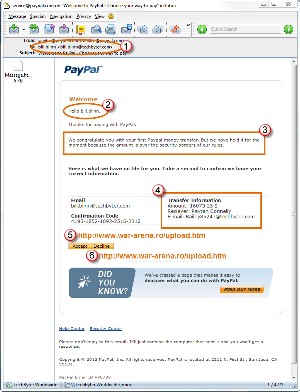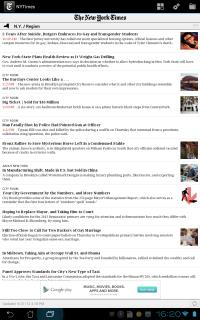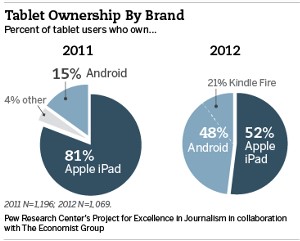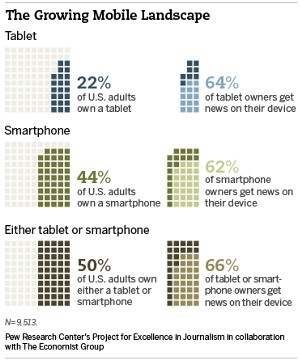Increasing Internet Threats Annoy and Alarm
Although "Internet security" has always been somewhat of an oxymoron, trust is increasingly being eroded by spam, phishing, malware, and now state-sponsored malware. The threats come not just from e-mail, though, but can also arrive via Skype or other IP-based voice services and even by phone using the plain old telephone system (POTS).
Maybe you've received a phone call from someone claiming to be from Microsoft support or from your Internet service provider's support desk. You may be told that your computer is infected or that the computer is sending bad information to the server. We received one of those calls this week. "Your computer is sending the server a serious error message," the caller told my wife. At the time of the call, all of our computers were turned off.
Microsoft doesn't make calls like this. Most ISPs don't, either. If you receive a call like this, ask for the person's name and ID number. Then tell the caller that you will contact the support department yourself. Don't accept any phone numbers or URLs that they try to provide; after all, I can call you, tell you that I'm from Microsoft, give you my Skype number, and then answer "Microsoft Support, this is Bill" when you call the number I gave you.
Most Skype subscribers have received fraudulent calls from an organization plays a recorded message that claims the user's computer is infected and provides a URL for the "repair". I don't understand why Skype can't find a way to shut this operation down but apparently the challenge is too great.
 Even standard fraudulent e-mails seem to be improving. Here's one that claims to be from PayPal. If you're a PayPal user, you probably know that PayPal always uses your name instead of saying "Dear Pay Pal User". Well, this message had my name (more or less). The fraudster used part of my e-mail address ("bill.blinn"). My name has capital letters in it and no period between the names. This is also not the spelling that PayPal has so it's still an amateurish fraud. Some years ago, I warned that relying on the presence of your name wouldn't be a good idea because the fraudsters would eventually figure this out. They're closer now.
Even standard fraudulent e-mails seem to be improving. Here's one that claims to be from PayPal. If you're a PayPal user, you probably know that PayPal always uses your name instead of saying "Dear Pay Pal User". Well, this message had my name (more or less). The fraudster used part of my e-mail address ("bill.blinn"). My name has capital letters in it and no period between the names. This is also not the spelling that PayPal has so it's still an amateurish fraud. Some years ago, I warned that relying on the presence of your name wouldn't be a good idea because the fraudsters would eventually figure this out. They're closer now.
Click any of the smaller images for a full-size view.
But there's a lot that tells me this is a fraud with only a cursory glance. Let's count the ways.
- The fraudster sent the message to an address I don't use for PayPal.
- As already noted, my name is wrong.
- "But we have hold it for the moment because the amount is over the security borders of our rules." This is not a sentence that has been written by a native speaker of English, even a lawyer.
- This is the United States and we place the currency symbol to the left of the number. PayPal knows this. Because the integer part of the number consists of 5 digits, there would be a comma. Additionally, the e-mail address is "@techbyter.com" and I assign all addresses for this domain.
- The Accept button links to a site in Romania.
- The Decline button links to the same site in Romania.
The Situation is About to Become Much Worse
Google has started warning people who use G-Mail or the company's Chrome browser about what it terms apparent state-sponsored attackers. Google has been displaying these messages for about 3 months but lately there's been a sharp spike in attacks.
Don't panic if you see one of these alerts. Google says the warning doesn't mean that your account has been hijacked. "It just means that we believe you may be a target, of phishing or malware for example, and that you should take immediate steps to secure your account." Additionally, Google says that these warnings are not shown because Google's internal systems have been compromised or because of a particular attack.
Google's suggested response is a multi-step process:
- Create a unique password that has a good mix of capital and lowercase letters, punctuation marks, and numbers
- Enable Google's 2-step verification process. Although annoying and time-consuming, this process strengthens your system's security.
- Update your browser, operating system, plugins, and document editors.
Google's security team warns that attackers often send links to fake sign-in pages in an attempt to steal passwords, so you should be careful about where you sign in to Google and look for https://accounts.google.com/ in the browser bar.
In June, many Google users were surprised to see an unusual greeting at the top of their G-Mail inbox, Google home page or Chrome browser. “Warning: We believe state-sponsored attackers may be attempting to compromise your account or computer.”

Google Information Security Manager Mike Wiacek says the state-sponsored attacks have grown dramatically in the past 3 months and that this week Google began warning tens of thousands of additional users about the attacks.
The attacks seem to be directed primarily at high-profile US journalists and employees of various political think tanks. Although Wiacek says that there has been a spike in suspected state-sponsored activity from the Middle East, he will specify only "various countries" in the region, none by name.
The New Newspaper
Many years ago I subscribed to the New York Times. No delivery was available at my office and the home delivery arrived too late for me to take the paper to the office so I read it in the evening when the articles within were more than 24 hours old. In those days, the national edition closed around 6pm and other editions closed throughout the evening until the morning local edition closed around 11pm. WQXR, the classical-music radio station owned by the NY Times, ran a brief report at 9pm with the next day's newspaper headlines. That ancient history occurred to me in September when I signed up for full Internet access to the Times online.
I dropped my subscription to the New York Times because the articles were so old by the time that I had a chance to sit down with the paper that they were no longer meaningful. But I've missed the newspaper—both the national and international coverage and the New York regional coverage. Although one can easily read much of the newspaper online and the paywall isn't particularly difficult to circumvent, buying a $15-per-month subscription seemed to be the right thing to do.
Newspapers no longer have a single deadline. Because most newspapers offer constantly updated articles, the Internet is the perfect delivery mechanism and newspaper journalists set the standard by which others are judged. Except for the few all-news radio stations, radio has essentially abdicated any claims to be providers of news and local television news is the eye-candy equivalent of tabloid newspapers. Even the fabled television network news operations are mere shadows of what they once were.
I happen to be one of those people who leans toward agreeing with Thomas Jefferson, who said "Were it left to me to decide whether we should have a government without newspapers, or newspapers without a government, I should not hesitate a moment to prefer the latter." It can never be an either/or proposition, of course. Government is essential if you want to have highways, reasonably safe food, and such. But it's also important to have newspapers that employ reporters who poke their noses into government operations.
This is a tough time for newspapers, though. Once they could depend on two steady revenue streams: Auto dealerships and want ads. Today that is not the case. Most auto dealerships have moved most of their advertising to the Web and Craig's List has destroyed the newspaper want ads. As advertising shrinks, so does what newspaper folks call the "news hole", the part of the paper not occupied by ads that can be filled by journalists.
Whatever you pay for the newspaper that's on your doorstep every morning is only a fraction of the cost of producing the newspaper. The rest of the cost is carried by advertisers and as newspaper advertising declines, so does the size of the newspaper. That's just one of the problems newspapers are facing. The other is the only old people like me depend on printed newspapers for news. Take a look around your neighborhood some morning and see how many houses have newspapers in the driveway. If you live in an area where most people are under 60, you probably won't see many. These folks get their news via the Internet.
So newspapers need to change. The transition is hard but I think that those who survive will be profitable. If you can deliver the newspaper electronically, you'll eliminate printing presses, press operators, the cost of the printing press building, trucks, and the drivers who deliver newspapers to homes. Compared to the cost of journalists, newsrooms, and news-gathering operations, the delivery costs are huge.
Consider as an analog, the Encyclopædia Britannica. You can't buy a printed copy of the encyclopedia any more but you can buy a DVD copy or subscribe to an online version. Maybe that's a bad example because Wikipedia is poised to be the winner in this space. But the cost of paying experts to prepare articles is a fraction of the cost of printing, warehousing, shipping, and delivering books.
Home delivery of the New York Times costs $400 per year and the printed version in Ohio omits sections that are considered to be of interest only to those who live in the New York Region. The Internet version of the paper costs just $180 per year ($0.50 per day) and it includes everything that's in the printed version.
 Here's what I see on my Android tablet. This is the NY/Region section of the news.
Here's what I see on my Android tablet. This is the NY/Region section of the news.
Does it look like a newspaper? No.
It looks like a Web page that lists the stories that were in the day's newspaper, along with any updates that have occurred since the paper was published.
 If photographs accompany the account, they are provided on the Web version of the newspaper and the quality is probably better than what would be found in the print version of the paper.
If photographs accompany the account, they are provided on the Web version of the newspaper and the quality is probably better than what would be found in the print version of the paper.
Eliminating Paper
If newspapers could eliminate the print version entirely and immediately, they could reduce the overall cost of a subscription. I suspect that today's subscribers to the online version are, to some extent, underwriting the costs of preparing the print version of the newspaper.
Which newspaper will be the first to say Enough! We are eliminating the print version of the newspaper!
For newspapers to survive, they will need to be destroyed and I say that with a nod to Peter Arnett's quote of an unnamed US officer during the Viet Nam War. Arnett quoted an officer who was involved in a battle at Bến Tre 7 Feb 1968: "It became necessary to destroy the town to save it."
But simply put: If newspapers want to survive, then they must stop printing.
 The Web-based display differs considerably from the tablet app and if you prefer the Web version to the tablet version, you can also view the Web version on your tablet. On the Web, the newspaper looks more like a traditional newspaper with columns but it's exceptionally long.
The Web-based display differs considerably from the tablet app and if you prefer the Web version to the tablet version, you can also view the Web version on your tablet. On the Web, the newspaper looks more like a traditional newspaper with columns but it's exceptionally long.
The user can drill down into the various primary sections (World, U.S., Politics, New York, Business, Dealbook, Technology, Sports, Science, Health, Arts, Style, Opinion) and the lesser sections (Autos, Blogs, Books, Cartoons, Classifieds, Crosswords, Dining & Wine, Education, Event Guide, Fashion & Style, Home & Garden, Jobs, Magazine, Movies, Music, Obituaries, Public Editor, Real Estate, Sunday Review, T Magazine, Television, Theater, Travel, and Weddings/Celebrations) are listed below.
The Conundrum
This will work for the New York Times and the Washington Post. It might work for the Chicago Tribune and the Los Angeles Times. If management is smart, it could work for smaller newspapers such as the Columbus Dispatch, the Cleveland Plain Dealer, and the Des Moines Register. But I feel that newspapers such as the Bellefontaine Examiner, the Dayton Daily News, and the Springfield Sun are doomed.
That's what concerns me.
The Clear Channelization of radio has eliminated what used to be a farm team: People who wanted to work in radio station news departments or who wanted to be disc jockeys could start at stations in small towns (Bellefontaine), move up to medium towns (Lima), transition through larger towns (Toledo), reach one of the major markets (Columbus, Pittsburgh, Indianapolis), and maybe make the big time (New York, Chicago, or Los Angeles). Today there is no farm-team system. You hear voices from major markets on radio stations in small, medium, and larger towns or you hear network-provided programs that appear on all stations nationwide. I have no idea where tomorrow's talent will come from.
Newspapers will be the same. The New York Times will survive. So will most of the other newspapers you've heard of. But as current subscribers die, smaller papers are going to find it difficult to pay even fresh-out-of-college reporters. And because of that, the newspaper farm-team system also seems to be doomed.
Apparently we'll need to destroy the town to save it.
Whether smaller newspapers survive or not (and I hope they find a way to), the larger newspapers seems poised to succeed.
Where Your News Will Come From (or Already Is Coming From)
It was startling to learn that more than half of the US population now owns either a smart phone or a tablet. Granted, most of these people probably have smart phones but I know a lot of people who have both smart phones and tablets. In addition, many have notebook computers and some still have desktops. Computing devices, after all, are tools and—just like hammers and screwdrivers—one size does not fit all.
I've been wrong about this technology twice. Back in the 1980s I thought that the market for mobile phones would be limited. In my defense, mobile phones in those days weighed 10 pounds and were the size of a brief case. But then, just a few years ago, I looked at Apple's Ipad and wondered who would want one of those. As it turned out, a lot of people wanted one of those and I now have an Android tablet that I use regularly.
Smart phones zoomed from 5% market penetration to just shy of 50% in about 4 years. That's about how fast television gained acceptance in the early 1950s but far faster than just about any other technology. By comparison, regular telephones didn't reach half of the population for nearly 40 years. It took 15 years for electricity to reach half of the population. The Internet, once it became generally available, hit 50% market penetration in about 5 years. Tablet ownership hit 10% penetration in about 3 years and exceeded 20% at mid year (currently 22% according to some surveys) as more companies offer more products in that market space.
Nothing illustrates that more that research by the Pew Research Center that shows Apple's market-leading Ipad about to dip below 50% market share. Pew says that fully one quarter of all US adults now own a tablet computer of some sort.
What surprised me, though, is the speed with which Android devices have caught on and this raises the question about how much market share Microsoft's upcoming tablets will steal from Apple.
According to the Pew report, "[J]ust over half, 52%, of tablet owners report owning an iPad, compared with 81% in the survey a year ago. Android-based devices make up the bulk of the remaining tablet ownership, 48% overall, dominated largely by the Kindle Fire. Two in ten, 21%, own a Kindle Fire, 8% the Samsung Galaxy, and the rest, a mix of others. (These numbers match very closely with sales data which put the Apple iPad at 61% of world sales, Android devices at 31% and Windows at 4%.)"
 It's worth noting that the survey predates the introduction of Google's Nexus 7 and Amazon's Kindle Fire HD. Additionally, the smart phone market, where Apple is a strong player, is increasingly an Android-based phenomenon.
It's worth noting that the survey predates the introduction of Google's Nexus 7 and Amazon's Kindle Fire HD. Additionally, the smart phone market, where Apple is a strong player, is increasingly an Android-based phenomenon.
Pew's research also notes that brand loyalty is a factor. More than half of the people who own both an Ipad and a smart phone have an Iphone. An even larger percentage of people who own an Android tablets and a smart phone have an Android-based phone. This makes a great deal of sense because equivalent operating systems are used on Ipads and Iphones just as equivalent operating systems are used on Android tablets and Android smart phones.
And What Are We Using those Tablets For?
When we're on the go, reading e-mail and writing quick responses is a popular use. I'm starting to receive tablet-based responses to messages even from people who are in the office. But another big draw is the ability to check news sites around the world.
Another Pew Research project considers the implications of these changes for how we will receive our news and also for how we'll pay for it. The research was conducted by Amy Mitchell, Tom Rosenstiel and Laura Houston Santhanam of the Pew Research Center's Project for Excellence in Journalism and Leah Christian of the Pew Research Center in collaboration with The Economist Group.
Many organizations have tablet-based applications for their own publications but these seem to be falling out of favor. The report says that 60% of tablet users select a browser application instead of the publication's app. "[J]ust 23% get news mostly through apps and 16% use both equally." Browser-only readers interact at a more superficial level, though. "[A]pp news users—and those who use both apps and the browser equally—remain in many ways more engaged and deeper news users than those who mostly use their browser."

USED WITH PERMISSION
Organizations such as the New York Times charge a single monthly fee that allows users to view the publication on smart phones, tablets, and computers using either the publication's application or a browser. Those who subscribe to the print-based version of the newspaper have full access to the electronic version.
 At one time, mobile devices might have been used as replacements for what radio news used to provide: A headline service. Now, say the researchers, portable devices are being used to read longer articles, too. "73% of adults who consume news on their tablet read in-depth articles at least sometimes, including 19% who do so daily. Fully 61% of smart phone news consumers at least sometimes read longer stories, 11% regularly."
At one time, mobile devices might have been used as replacements for what radio news used to provide: A headline service. Now, say the researchers, portable devices are being used to read longer articles, too. "73% of adults who consume news on their tablet read in-depth articles at least sometimes, including 19% who do so daily. Fully 61% of smart phone news consumers at least sometimes read longer stories, 11% regularly."
What worries publishers and the journalists they pay to report the news is how or whether people will pay for electronic content. Although many would work for free if they had other sources of income, journalists have the same needs as the rest of us: Providing housing, food, and such for themselves and their families.
The research says "More mobile news users have print-only subscriptions than have digital ones. Just 24% of them are considering exchanging their print subscription for a digital one (though these tend to be younger subscribers, which suggests their numbers will grow)." This would seem to parallel telephone usage. Older people maintain wired telephones in addition to their mobile phones while younger people see no need for wired phones.
The old model for journalism required that most of the costs be picked up by advertisers with readers paying only a minimal part of the production cost but two of the most productive revenue sources for newspapers have dried up: Automobile dealers are using websites to market cars and trucks and services such as Craig's List have decimated (in the most literal sense of that word) the want-ads.
The good news for advertisers is that "[p]eople notice ads on mobile devices and may be even more likely to click on them than they are to click on other digital ads." Whether the ads are productive is another question, though, and both click-through and conversion rates are relatively low.
"Click-through" refers to a reader's active selection of an ad and following the link. "Conversion" indicates that the consumer has made a purchase. The study notes research by Ad Age that shows click-through rates on browser-based display ads to be less than 1%.
Short Circuits
Cyber Attack Swatted but This Is No Time to Feel Safe
White House spokesman Jay Carney told reporters this week that computer security systems installed at the White House detected an attempt to infiltrate computers there, isolated the threat, and removed it. Hurrah! But what about next time?
Carney noted that the White House has more than a single network. Some contain classified information and are more hardened against attack while others contain no secure data. Carney didn't say whether there are any interconnections between the two networks. There shouldn't be.
The attack was apparently a "spear-phishing" attempt in which the attackers pursue a small, select group of people with highly convincing forgeries of what may appear to be legitimate documents from known sources. Carney says such attacks are common.
They're common elsewhere, too. Google believes that Chinese military personnel conducted an attack against it last year and the military is under constant attack from snoops.
Congress considered a cyber security bill this summer but couldn't pass it. Many security experts consider electric grids, banks, and other critical business and government operations to be at risk. Currently the Obama administration is working on an executive order that would accomplish some of what Congress was unable to do.
The order would establish voluntary cybersecurity standards for businesses and the Department of Homeland Security would review to process. Executive orders can be eliminated by subsequent administrations and mandated cybersecurity measures are strongly opposed by business interests.
Yes, you read that right: The very people who have the most to lose if their computers' security is breached are the ones who oppose it most. Business opposition is what kept Congress from acting this year.
Microsoft Settles Computer Fraud Case
A Chinese businessman has settled a fraud suit brought against him by Microsoft and Microsoft has withdrawn the suit. A domain run by Peng Yong had served as home base for at least one botnet and was implicated in the installation of malware on personal computers around the world.
Peng Yong is the owner of 3322.org. He has agreed to work with Chinese security experts and Microsoft to clean up the mess.
The Nitol botnet was housed at 3322.org and the domain served at least 500 types of malware according to the suit filed in September by Microsoft. Peng has agreed to re-route any traffic from his domain to a system that will be monitored by Chinese authorities.
Peng denied any wrongdoing. He didn't say, but perhaps should have, "I didn't do anything wrong and I won't do it again."
The Adobe Flood Continues
It seems like every week Adobe releases something new or updated and this week is no exception. The latest version of Adobe Acrobat (XI) is now available as are updates for Lightroom 4.2 and Camera Raw 7.2. Lightroom 4.2 is available as a free download for Lightroom 4 customers, and the Camera Raw plug-in is available as a free download for Photoshop CS6 customers; both are available for Mac and Windows.
In part, the frequent updates are necessary because camera manufacturers regularly release new models. The updates add Album Support within the Revel Publish Service; bring additional raw file support for 21 new cameras including the Canon EOS 650D/Rebel T4i, Fujifilm X-E1 and Sony DSC-RX100; provide tethered capture support for 11 new cameras; and add preliminary support for the Nikon D600 camera.
I've described the updates to these versions of Lightroom and Camera Raw previously but Acrobat XI is completely new and it became available to me only a few days before the final release.
Probably the most useful new feature is the improved editing capability. After I've had the opportunity to work with this version for a while, I'll know more but Adobe says that this version makes PDFs fully editable. That's something a friend of mine has been pressing for since at least 2005 and since 2005 I've been telling him that PDFs are based on the underlying Postscript code, which makes the kinds of features he wants all but impossible. But now text reflows, just like in a word processor. I'm sure there are limitations to this feature but I haven't yet had time to work with it enough to know where the boundaries are.
Acrobat XI integrates with Adobe's EchoSign service and this make it easy to provide a document, such as a sales contract, online for a customer to sign. This capability extends an existing "signing" option and simplifies the process. If you have a PDF document and you need a PowerPoint document, try the Acrobat Export feature that adds to the existing capabilities to export to Word and (as appropriate) Excel formats.
That's not the end of the story for Acrobat. Stay tuned!



 The author's image: It's that photo over at the right. This explains why TechByter Worldwide was never on television, doesn't it?
The author's image: It's that photo over at the right. This explains why TechByter Worldwide was never on television, doesn't it?
